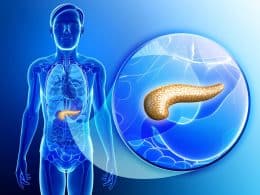Vitamin A is an essential nutrient that plays an important role in the human body. It occurs naturally in foods that you eat and can be taken as a supplement.
Although considered to be a single nutrient, Vitamin A is the name given to a group of fat-soluble compounds, which include retinal, retinol, retinoic acids, and provitamin A carotenoids.
Vitamin A is necessary for the maintenance of the immune system, good vision, and growth and development.
The nutrient is required by the retina of the eye in the form of retinal, which combines with other proteins necessary for low-light and color vision. Retinoic acid, a form of vitamin A is needed for cell and tissue growth.
Vitamin A exists in animal food sources as retinyl palmitate, which is then converted to alcohol in the small intestine.
The body stored vitamin A as retinol and can be converted to and from retinal. Retinol is absorbed when eating animal food in the form of a yellow fat substance. It is also commercially produced as esters like palmitate or retinyl acetate.
Animal sources of retinol include liver, fish, and dairy products, which sources of provitamin A carotenoids can be found in plant sources like fruits, vegetables, and oils.
Functions of Vitamin A
Vitamin A is best known for its role in vision and eye health. Retinal, a form of vitamin A, combines with the protein, opsin, to form rhodopsin. Rhodopsin is a molecule necessary for low-light vision and color vision.
Vitamin A is also responsible for the protection and maintenance of the cornea and conjunctiva. The cornea is the outermost layer of the eye, while the conjunctiva is the thin membrane that covers the surface of the eyes and the inside of the eyelids.
Furthermore, vitamin A helps to maintain tissues such as the skin, lungs, inner ear, bladder, and intestine.
It provides support for the immune system by supporting the growth and the redistribution of the T-cells – a type of white blood cell that shields the body from infection.
Additionally, the nutrient helps to maintain healthy skin and supports male and female reproduction and the development of the fetus.
Health Benefits of Vitamin A
Antioxidant properties
Vitamin A has antioxidant properties that help fight free radicals that can harm the body by creating oxidative stress. Provitamin A carotenoids like alpha-carotene, beta-carotene, and beta-cryptoxanthin are components of vitamin A with antioxidative properties.
Chronic illnesses such as diabetes, heart diseases, and cancer are examples of diseases that can be caused by free radicals. These can be combated with diets high in carotenoids, which reduces the risk of these conditions.
May lower the risk of cancer
Foods rich in carotenoids such as fruits and vegetables may protect against certain types of cancer due to their antioxidant properties.
A study conducted in over 10,000 adults shows that smokers with high levels of vitamin A precursors had a lower risk of dying from lung cancer than non-smokers with lower intake of vitamin A.
Another study showed that retinoids might inhibit the growth of certain types of cancer cells, such as those of ovarian, breast, and bladder cancer.
Essential for fertility and development of the fetus
Vitamin A is necessary for both male and female reproduction. It plays a vital role in the formation and development of sperm and egg. It is also crucial for the health of the placenta and fetal tissue development, maintenance, and growth.
Boosts the immune system
Vitamin A is required by the immune system to protect the body against diseases and infections. It is involved in the creation of the T-cells, which play vital roles in the immune system responses that shield the body against diseases.
Lack of vitamin A can lead to increased levels of infections that compromise the immune system.
Necessary for eye health
Adequate intake of vitamin A maintains eye health and helps guard the eyes against certain diseases such as conjunctivitis and other age-related eye diseases.
Sources of Vitamin A
Animal sources of vitamin A include:
- Beef liver
- Salmon
- Chicken liver
- Egg yolk
- Cod liver oil
- Cheddar cheese
- Liverwurst
- Mackerel
- Liver sausage
Plant sources of vitamin A include:
- Pumpkin
- Carrots
- Spinach
- Cabbage
- Red peppers
- Kale
- Dandelion greens
- Parsely
- Collard greens
- Swiss chard
The body readily absorbs vitamin A from animal sources than from those from plant sources. The rate at which your body absorbed vitamin A from plant sources depends on genetics, diet, and medications.
Recommended Intake for Vitamin A
The dietary intake of vitamin A varies and depends on the age and sex of the individual.
Vitamin A can be obtained from food and supplements. The vitamin A content in food is typically measured as retinol activity equivalents (RAEs).
1 RAE = 1 microgram (mcg) of retinol, 12 mcg of beta-carotene, or 3.33 International Unit (IU) of vitamin A.
The recommended intakes of vitamin A are as follows:
- The requirement is 300 mcg per day from 1- 3 years
- 400 mcg per day from 4-8 years
- 600 mcg per day from 9-12 years
- From 14 years, vitamin A requirement for males is 900 mcg per day, and for females, 700 mcg daily
- For women between the ages of 19 to 50 years, the demand is 770 mcg per day during pregnancy and 1,300 mcg per day while breastfeeding
Vitamin A Toxicity
It is important not to exceed the tolerable upper limit 3,000 mcg for adults to prevent toxicity
Although it’s possible to consume excess vitamin A from animal sources, the toxicity of the nutrient is often associated with excessive intake of vitamin A supplement and treatment with medications, such as Isotretinoin
Vitamin A stored in the body can reach unhealthy levels over time due to its fat-soluble nature. Excess intake of vitamin A can have severe side effects and can even be fatal if ingested in high doses.
The most common side effects of vitamin A toxicity, also known as hypervitaminosis A include:
- Vision impairment
- Pain in the joints and bone
- Nausea and vomiting
- Photosensitivity
- Poor appetite
- Alopecia (Hair loss)
- Dry, itchy skin
- Headache
- Liver damage
- Delayed growth
- Jaundice
- Confusion









